
- முகவரி: த.பெ. இல. 11, கண்ணொருவ, பேராதெனிய, இலங்கை.
- மின்னஞ்சல் : director.hordi@doa.gov.lk
- தொலைபேசி :(+94) 81-2388011-12-13
- தொலைநகல்:(+94) 81-2388234

தக்காளி
Solanum lycopersicon
Popular vegetable crop belonging to Solanaceae. Can be grown in almost all agroclimatic zones in Sri Lanka except up country wet zone. It is an important cash crop and also has a good potential for export. Tomato fruit rich in vitamin A, C and minerals.
Released Varieties
- HORDI Tomato hybrid 03
- Thilina
- KWR
- T245
- Ravi
- Lanka Sour (Goraka Takkali)
- Maheshi
- Tharindu
- Rajitha
- Rashmi
- Bhathiya
- KC 1
- Lanka Cherry
Climate requirements/ Areas suitable for cultivation
Optimum climatic conditions are
- 21oC-24oC temperature.
- PH should be in between 5.5-7.5
- Elevation 1000-2000 m
Soil
Tomato is moderately tolerant to a wide range of pH, but grows well in soils with a pH of 5.5-7.5 addition of organic matter is in general favorable for good growth.
Seed requirement
200-250 g/ha
Nursery Management
Suitable period is mid of March or end of August. 1 m x 3 m size raised bed (about 15-20 cm raised) is recommended. Remove clods of earth and stubble. Mix well decomposed farmyard manure and top soil 1:1 ratio and lay on the bed to 5cm thickness . Apply fungicide (Thiram or captan) put paddy husk and straw layers on the Surface of the bed and fire from the opposite of the wind direction and burn the seed bed. Apply 2g of a fungicide ( Captan or thiram) to 125g of seeds as a seed treatment before place in the nursery . Draw lines 12-15cm apart over the length of the seed bed. Sow the seed thinly spaced on the lines and press gently. covering the seeds with fine sand.Water the bed daily and mulch it using clean paddy straws.
Land preparation
Harrow the soil and break soil finely. Mark pits according to given spacing fill the pits with decomposed manure or organic matter( 6-12 mt/ha). Make several drains to avoid water retention. Apply basal fertilizer 2-3 days before transplanting
Planting
Transplant the seedling to the field 14-18 days after sowing. A week before transplanting seedlings should be hardened by reducing the application of water but 12-14 hours before they are taken out of the seedbed they should be thoroughly watered again to avoid excessive damage to the roots. Seedlings of 15-25 cm tall with 3-5 true leaves are most suitable for transplanting. Transplanting should be done in the afternoon or on a cloudy day to reduce the transplanting shock. If the transplanting is done in shiny day the transplanted plants should be covered with twigs of plants like Glyrisidea.
Spacing
08 cm x 50 cm
Fertilizer
Mix 10 t/ha of well decomposed organic matter. Additionally apply chemical fertilizers as recommended. Apply basal fertilizers 2-3 days before planting
Chemical fertilizer recommendation for all district except Badulla District.
Times for apply | Urea kg/ha | TSP kg/ha | MOP kg/ha |
Basal fertilizer – 1-2 days before planting | 65 | 325 | 65 |
Top dressing (03 weeks after planting) | 65 | – | – |
Top dressing ( 06 weeks after planting) | 65 | – | 65 |
Apply the above recommended triple super phosphate per hectare for Badulla District at the rate of 215 kg / ha.
Water supply
Don’t apply excess water specially in dry season. It cause fruit crack.
Weed Control
When plants are young specially 3-6 weeks after transplant, remove weeds by hand around the plants. And also weeding should be done before apply fertilizers Always keep the cultivation free of weeds. It will reduce the risk of pests and diseases.
Pest Management
நோய் முகாமைத்துவம்
- பங்கசு நோய்
 |
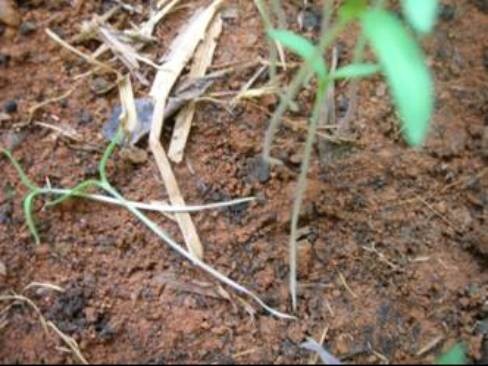 |
- ஆரோக்கியமான நிலத்தில் நாற்றுமேடை பாத்திகளை தயார் செய்தல்
- வெப்ப தொற்றுநீக்கம்
- வித்து சிகிச்சை திராம் 80 WP 5g/1kg அல்லது ஹொமய் 4g/1kg
- மண் சிகிச்சை திராம் 80 WP 7g/5லீ/m2 அல்லது ஹொமய் 5g/5லீ/m2
 |
 |
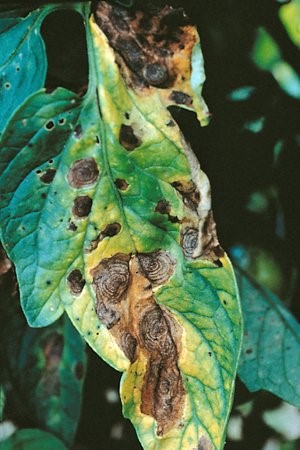 |
- நோய் விருத்தி அடையும் ஆரம்ப நிலையிலேயே பரிந்துரைக்கப்பட்ட பங்கசு நாசினிகளின் பாவணை (குறிப்பு – DOA பீடைநாசினி பரிந்துரை, 2019)
- முதலில் அடி இலை, முதிர்ந்த இலைகளில் ஈரத்தன்மையான சாம்பல் பச்சை நிற புள்ளிகள் தோன்றும்
- பின்னர் புள்ளி கருமையாகி, கீழ் புறம் வெள்ளை பூஞ்சண வளர்ச்சி புள்ளிகளைக் காணலாம்
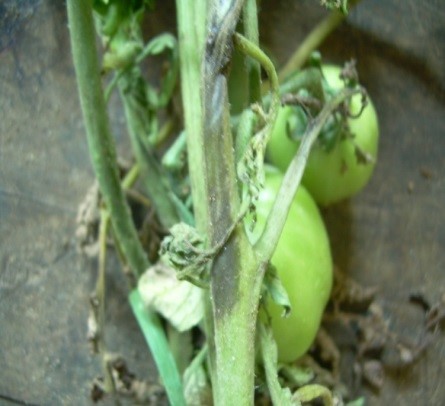 |
 |
 |
- நோய் அபிவிருத்தி அடையும் ஆரம்ப நிலையில் பரிந்துரைக்கப்பட்ட பங்கசு நாசினி பயன்பாடு (குறிப்பு : DOA பீடைநாசினி பரிந்துரை 2019)
நோயாக்கி : Corynespora cassiicola
அறிகுறிகள்:
- மஞ்சள் ஒளி வட்டத்தால் சூழ்ந்த இலைகளின் மேல் செறிந்த நிலையில் வட்டமான, கடும் கபில நிற புண்கள் காணப்படும் மற்றும் அணைத்து இலைகளுக்கும் பரவும்
- இலைகள் மஞ்சளாகி தொடர்ந்து அழிவடைந்து இறக்கும்
- தண்டு மற்றும் பழங்களிலும் புள்ளிகள் தோன்றும்
 |
முகாமைத்துவம் பொருத்தமான பங்கசு நாசினி பரிசோதனையின் கீழ் உள்ளது.
- இலையின் மேற்புறத்தில் இளம் பச்சை முதல் பிரகாசமான மஞ்சள் புண்கள் காணப்படும்.
- பங்கசு வித்தியாக்கத்தின் போது கீழ் பரப்பில் வெள்ளை பற்றைகள் விருத்தியாகும்
- தீவிர தொற்றில் இலை உதிரும்
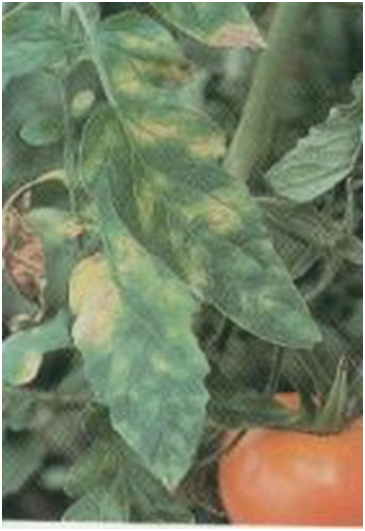 |
- நோயின் ஆரம்பநிலையில் பரிந்துரைக்கப்பட்ட பங்கசு நாசினி பாவணை (குறிப்பு DOAன் பங்கசு நாசினி பரிந்துரை 2019)
- சல்பர் 80% WG 50g/10லீ நீருக்கு சேர்த்தல்
- குளோரோ தெலேனில் 500g/ 5C-30மி.லீ / 10லீ நீருக்கு
- கார்பென்டசிம் 50% WP – 7g / 10லீ நீருக்கு
- நுனி மொட்டுகளில் இருந்து இறக்கும், பூக்கள் உதிரும்
- இலை, தண்டு மற்றும் பழங்களில் கருப்பான, குழிவான புண்கள் காணப்படும்.
- பழ அழுகல்
 |
- விதையிட முன் பரிந்துரைக்கப்பட்ட பங்கசு நாசினியால் வித்து சிகிச்சையளித்தல்
- நோய் விருத்தியடையும் ஆரம்ப நிலையில் பரிந்துரைக்கப்பட்ட பங்கசு நாசினி பாவணை (குறிப்பு DOAன் பீடைநாசினி பரிந்துரை, 2019)
நோயாக்கி : Septoria lycopersici
அறிகுறிகள் – பாதிக்கப்பட்ட இலைகளில் நீர் ஊரிய பகுதிகள் கபிலத்தில் இருந்து சாம்பல் நிற மையம் உடைய வட்டங்களாகும்.
கட்டுப்பாடு – பரிந்துரைக்கப்பட்ட பங்கசு நாசினி பாவணை
டெகொனில் 15-30மி.லீ / 10லீ
மெங்கொசெப் -20மி.லீ / 10லீ
டொப்சின் 6g / 10லீ
கார்பென்டசிம் 7g / 10லீ
நோய் காரணி : Fusarium spp., Rhizoctonia spp., Sclerotium spp.
நோய் அறிகுறிகள் – நோயாக்கி தாவரத்தின் கழுத்து பகுதியை தாக்கும். தொற்று தாழ் மட்ட இலைகளை உலர செய்தல் மற்றும் முழு தாவரமும் உலர்தல் என்பன வாடலின் முக்கிய அறிகுறியாக இருப்பதோடு இறப்புக்கு வழிவகுக்கும்
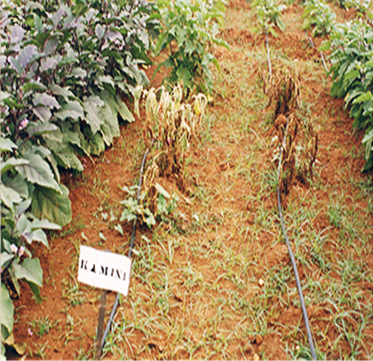 | 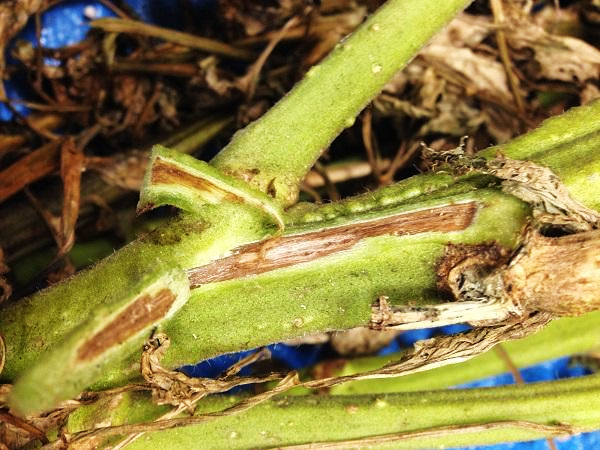 |
- பற்றீரிய நோய்கள்
நோய் காரணி : Ralstonia solanacearum
நோய் அறிகுறிகள்
- போதிய நீரானது மண்ணில் காணப்படும் போதிலும் நிரந்தர வாடல் நிலை ஏற்படல்.
- தெளிவான நீரில் அடி வெட்டப்பட்ட பகுதியை இடும் போது வீரியமான திரவ வெளியீடு
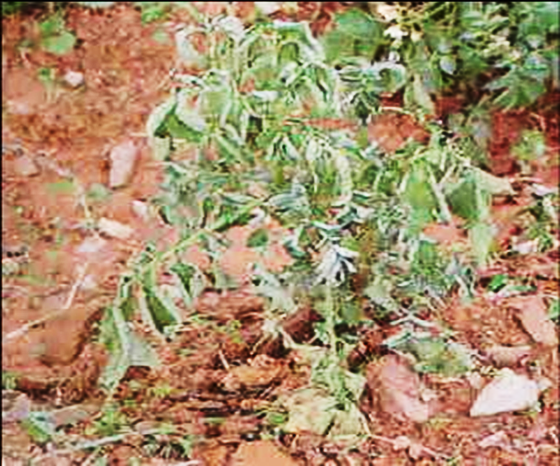 | 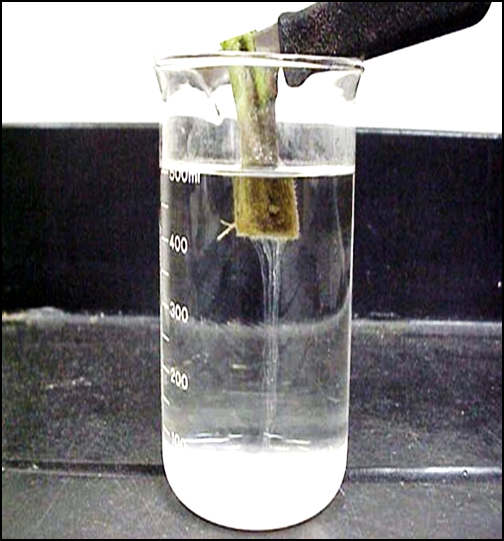 |
முகாமைத்துவம்
- வாடல் எதிர்ப்பு திறனுடைய வர்க்கங்களின் பாவனை
- அவரையினங்கள், தானியங்களுடனான பயிர் சுழற்சி முறை
- களத்தை தூய்மையாக பேணல்
நோய் காரணி : Clavibacter michiganensis subsp. michiganensis (Cmm)
நோய் அறிகுறி:
- தக்காளி இலைகளின் விளிம்புகள் மஞ்சள் ஒரங்களுடனான கபிலமாகும்.
- அடிக்கடி ஒரு பக்கம் மாத்திரம் தாழ்மட்ட இலைகளில் வாடல் ஏற்படல்
- முழு தாவரமும் சாய்ந்து இறத்தல்
- தண்டு வெட்டப்பட்டு திறக்கும் போது கடத்தும் நரம்பு தொகுதிகளில் கபில நிற கோடுகளை காணலாம்
- தண்டுகள் நீளமாக வெடித்து கபில நிற புற்றுநோய் ஏற்படும்.
- பற்றீரிய புற்று நோயால் தண்டில் உள்ளக நிறமாற்றம் ஏற்படும்
- பழங்களில் பழுப்பு அல்லது கபில மையத்துடனான சிறிய, கிறீம் போன்று வெள்ளை புள்ளிகள் தோன்றும் (பறவையின் கண் புள்ளி)
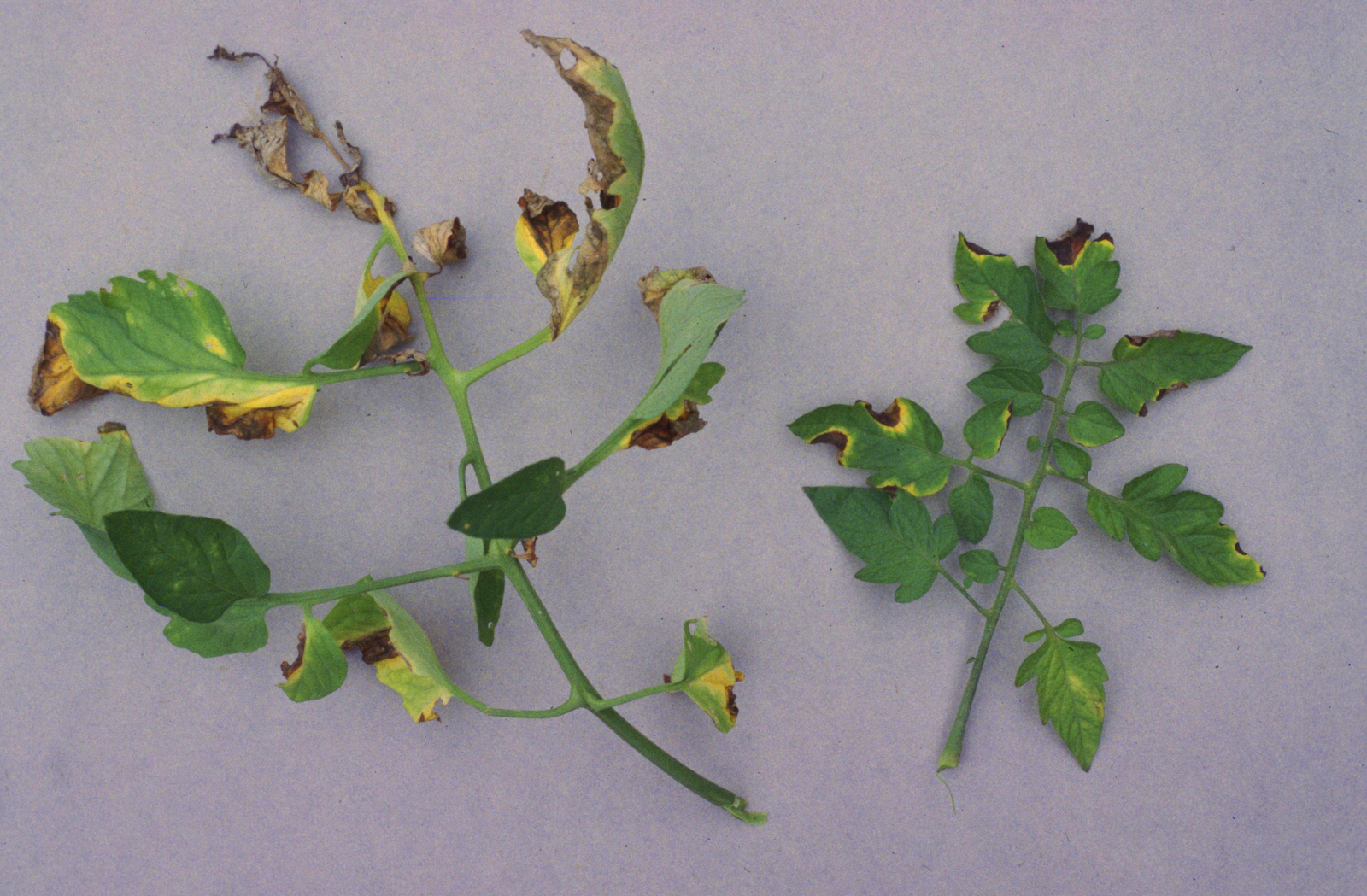 | 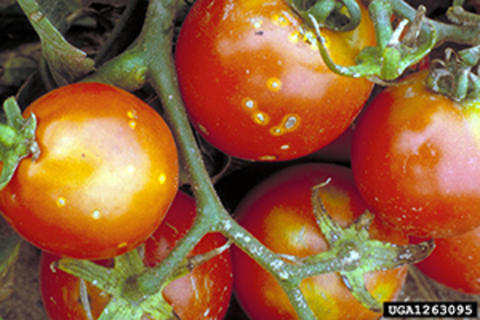 |
முகாமைத்துவம்
- ஆரோக்கியமான வித்து பாவணை
- பயிர் சுழற்சி
- களத் தூய்மையை பேணல்
- வைரஸ் நோய்கள்
TYLCV வெண் ஈ மூலம் கடத்தப்படுகிறது
அறிகுறிகள்
- இலைகள் மேல் புறமாக சுருளும்
- இலை விளிம்புகள் மஞ்சளாதல் (வெளிறல்)
- சாதாரண நிலையை விட சிறிய இலைகள்
- தாவரம் வளர்ச்சி குன்றுதல் மற்றும் பூக்கள் உதிர்தல்
- தக்காளி தாவர வளர்ச்சியின் ஆரம்பத்திலேயே பாதிக்கப்படுமாயின் அதில் காய் உருவாகாது
- களத்தில் முழுவதும் பாதிக்கப்பட்ட தாவரங்கள் தோராயமாக காணப்படும்
முற்பாதுகாப்பு மற்றும் சிகிச்சை
- களையகற்றல்
- பழைய பயிர் மிகுதிகளை அகற்றல்
 |
வைரஸ் நோய் முகாமைத்துவம்
- நோயற்ற வித்து பாவனை
- களைகளற்ற களம் மற்றும் கள தூய்மை
- காவி குடித்தொகையை குறைத்தல் (பூச்சி நாசினி மூலம்)
காவி – இலை தத்தி
- நடு நரம்பின் ஊடாக இலை உள்ளோக்கி சுருளல்
- பொதுவாக இலைகாம்பு மற்றும் நடுநரம்பு கீழாக சுருண்டு இலைகளை உதிரச் செய்யும் ஆனால் வாடல் தோற்றம் அல்ல
- இலைகள் தடிப்பான, மிருதுவான, நொறுங்கக்கூடிய மற்றும் மந்தமான பச்சை நிறத்துடனான ஊதா நரம்புகள்
முற்பாதுகாப்பு மற்றும் சிகிச்சை
- களையகற்றல்
- பழைய தாவர மிகுதிகளை அகற்றல்
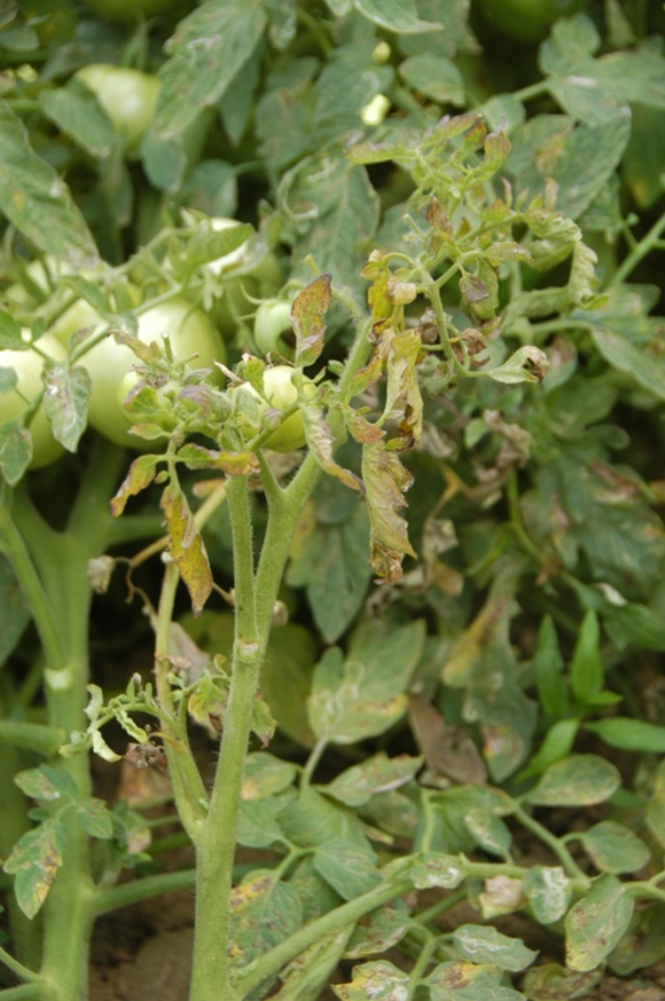 |
வைரஸ் நோய் முகாமைத்துவம்
- நோயற்ற வித்து பாவணை
- களைகளற்ற களம் மற்றும் கள தூய்மை
- காவிகளின் குடித்தொகையை குறைத்தல் ( பூச்சிநாசினிகள் மூலம்)
TSWV ஆனது சிறிய பூச்சியான அழுக்கணவனால் பரப்பப்படுகிறது.
அறிகுறிகள்
- தாவரத்தில் வெண்கலமாதல் சுருளல், வெளிரிய கோடு மற்றும் இலை புள்ளி என்பன தோன்றும்
- இலை காம்பு, தண்டு மற்றும் வளரும் நுனிகளில் கடும் கபில கோடுகளும் தோன்றும்
- தாவரம் சிறிதாக மற்றும் வளர்ச்சி குன்றியதாக காணப்படும்
- பழுத்த பழங்களின் தோல் வெளிர் சிவப்பு அல்லது மஞ்சளாக காணப்படும்.
- தீவிர வெளிரலால் தாவரம் இறக்கும்
முற்பாதுகாப்பு மற்றும் சிகிச்சை
- களையற்றல்
- பழைய தாவர மிகுதிகளை அகற்றல்
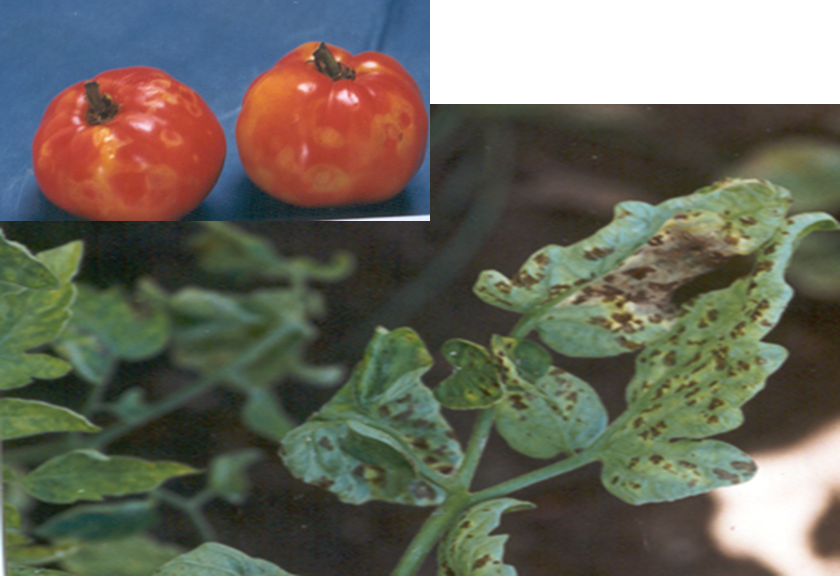 |
வைரஸ் நோய் முகாமைத்துவம்
- நோயற்ற வித்து பாவணை
- களைகளற்ற களம் மற்றும் கள தூய்மை
- நோய் காவிகளின் குடித்தொகையை குறைத்தல் ( பூச்சிநாசினி மூலம்)
CMV அழுக்கணவனால் பரப்பப்படுகிறது
அறிகுறிகள்:
- ஆரம்ப நிலையில் மஞ்சளாதல், கொத்தாக்கம் மற்றும் ஏற்றுக்கொள்ளக் கூடிய குறள் வளர்ச்சி, பின்னர் இலை விளிம்புகள் நூல் போன்று அல்லது காலணி கயிறு அமைப்பு
- இலை விளிம்புகளில் காலணி கயிறு போன்ற தோற்றம்
- இலையில் பன்னிற புள்ளியமைப்பு
 |
வைரஸ் நோய் முகாமைத்துவம்
- நோயற்ற வித்து பாவனை
- களைகளற்ற களம் மற்றும் களத்தூய்மை
- காவிகளின் குடித்தொகையை குறைத்தல் (பூச்சிநாசினி மூலம்)
Harvesting
Harvesting is done when the fruits reach green yellow and can be harvest 10-12 picks. The fruits should be soted according to the size and quality and should be stored at well aerated place.
Yield
Varies with season, variety and climate. Normally yields about 20-30 ton per hectare.
